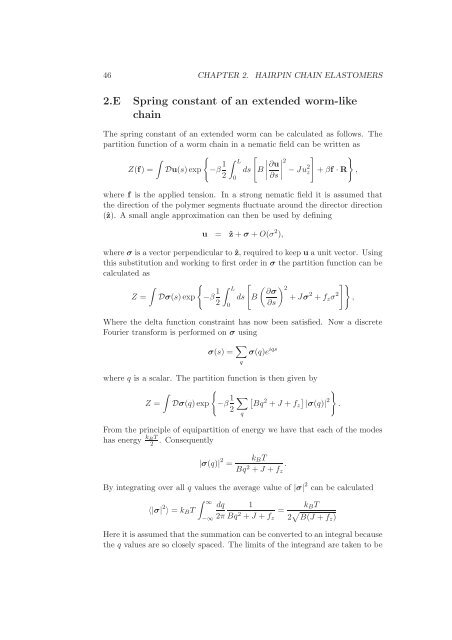Statistical models of elasticity in main chain and smectic liquid ...
Statistical models of elasticity in main chain and smectic liquid ...
Statistical models of elasticity in main chain and smectic liquid ...
You also want an ePaper? Increase the reach of your titles
YUMPU automatically turns print PDFs into web optimized ePapers that Google loves.
46 CHAPTER 2. HAIRPIN CHAIN ELASTOMERS2.E Spr<strong>in</strong>g constant <strong>of</strong> an extended worm-likecha<strong>in</strong>The spr<strong>in</strong>g constant <strong>of</strong> an extended worm can be calculated as follows. Thepartition function <strong>of</strong> a worm cha<strong>in</strong> <strong>in</strong> a nematic field can be written as∫ {Z(f) = Du(s)exp −β 1 ∫ [L] }ds B∂u22 ∣∂s∣−Ju 2 z +βf ·R ,0where f is the applied tension. In a strong nematic field it is assumed thatthe direction <strong>of</strong> the polymer segments fluctuate around the director direction(ẑ). A small angle approximation can then be used by def<strong>in</strong><strong>in</strong>gu = ẑ+σ +O(σ 2 ),where σ is a vector perpendicularto ẑ, required to keep u a unit vector. Us<strong>in</strong>gthis substitution <strong>and</strong> work<strong>in</strong>g to first order <strong>in</strong> σ the partition function can becalculated as∫ {Z = Dσ(s)exp −β 1 ∫ [L( ) ]}∂σ2ds B +Jσ 2 +f z σ 2 ,2 ∂s0Where the delta function constra<strong>in</strong>t has now been satisfied. Now a discreteFourier transform is performed on σ us<strong>in</strong>gσ(s) = ∑ qσ(q)e iqswhere q is a scalar. The partition function is then given by∫ {}Z = Dσ(q)exp −β 1 ∑[ Bq 2 ]+J +f z |σ(q)|2.2qFrom the pr<strong>in</strong>ciple <strong>of</strong> equipartition <strong>of</strong> energy we have that each <strong>of</strong> the modeshas energy k BT2 . Consequently|σ(q)| 2 =k B TBq 2 +J +f z.By <strong>in</strong>tegrat<strong>in</strong>g over all q values the average value <strong>of</strong> |σ| 2 can be calculated〈|σ| 2 〉 = k B T∫ ∞−∞dq 12π Bq 2 =+J +f zk B T2 √ B(J +f z )Here it is assumedthat thesummation can beconverted to an<strong>in</strong>tegral becausethe q values are so closely spaced. The limits <strong>of</strong> the <strong>in</strong>tegr<strong>and</strong> are taken to be
















